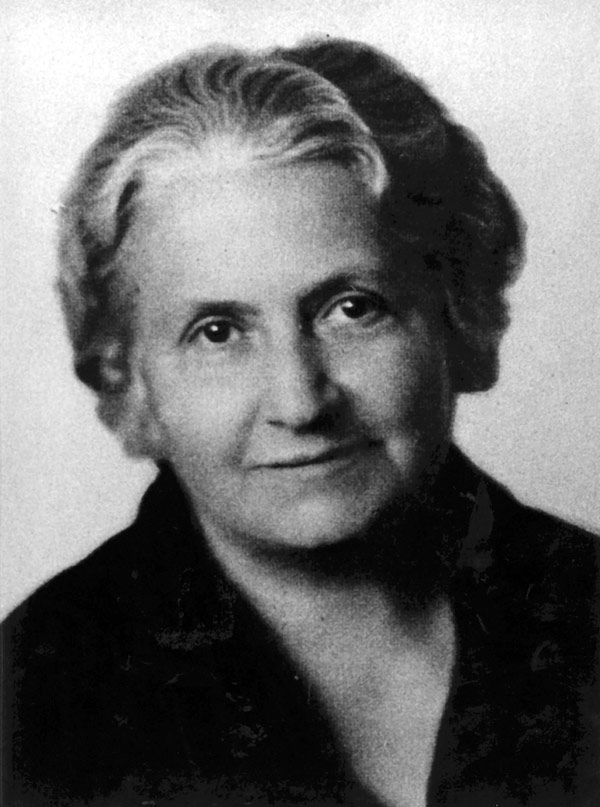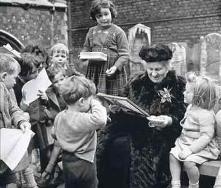Dr. Maria Montessori

Dr. Maria Montessori was born in Italy in 1870 and developed an approach to learning which today we call The Montessori Method.
Dr Montessori was the first woman physician in Italy and despite the difficulties of this exclusive environment, she became famous and respected by her contemporary colleagues in the area of medicine, psychology, engineering and education.
Maria Montessori spent her life advocating for the rights of children and women. Near the end of her life (1952) she was working with UNESCO to promote her self-directed education of students in secondary and university settings.
Among Dr. Montessori’s scholars were names such as Einstein, Edison and Piaget.
The Montessori method is now practiced in every continent, excluding Antarctica.
The Montessori Philosophy
Maria Montessori was a constructivist, meaning she believed that children endeavoured to construct their intellect and want to naturally acquire skills that lead to independence. She firmly believed that children are born with similar tendencies regardless of their culture or economic status. Her philosophy of education belongs with developmentalists such as Piaget (1896-1980), Johann Bernard Basedow (1724-1790), Johann Heinrich Pestalozzi (1746-1827), Georg Wilhelm Friedrich Hegel (1770-1831), Friedrich Froebel (1782-1852), Herbert Spencer (1820-1903), William James (1842-1910) and G. Stanley Hall (1844-1924).
Premises to the Methodology
A prepared environment is key to the Montessori method of teaching. Children are presented with an environment where didactic materials are displayed in a sequential arrangement. Children work with this equipment and construct learning through a manipulative (hands-on) concrete process. The materials are scientifically designed to isolate and highlight specific concepts. Within the environment, furniture is child sized which removes the disadvantage of a child struggling with an environment that is not completely functional. All items are aesthetic and made of natural materials, whenever possible. Maria Montessori believed that children learn to respect objects that are beautiful and fragile (eg. glass, ceramic, pottery) through their own natural curiosity and innate urge to learn.
School assessments are done through observation and through informal and formal methods; traditional methods of measuring educational achievement (tests, grades) are not viewed as the most important tools, but are used to ensure adults have some form of comparative testing for own learning. Competition is not discouraged if it is supportive of personal improvement and does not become an ‘us against them’ philosophy.
Summary
-
Children learn through movement and interaction with their environment
-
Children become responsible for their own learning and their actions
-
There are no rewards and punishments, but rather logical consequences and freedoms gained through discipline
-
Children work in an uninterrupted timeframe called the ‘Three Hour work cycle’
-
Observation guides the adult in presenting concepts that meet the child’s optimal learning stage (Sensitive Periods)
-
Information presented is always correct, scientifically proven and delivered with specific terminology that suits the content
-
Children correct their own mistakes with adult supervision and support each other through peer tutoring
-
Respect for all living things and the environment is an expectation
-
Children manage conflict resolution with mediation and facilitation until they become independent enough to develop their own strategies
The Environment
Each classroom has students of at least three age groups and they belong to a stage of development (0-3, 3-6, 6-9 and 9-12). The classroom preparation reflects the needs of the specific group of students in that environment. Materials are placed accessibly on shelves in the different learning areas: Practical Life, Sensorial, Mathematics, Language and Cultural areas.
All materials are complete and aesthetically pleasing. There is usually only one item of each piece of equipment so that children will learn to develop respect and patience. Children must replace everything they use exactly as they find it and if something is incomplete, it is removed from the room.
The Curriculum
 The process of learning in a Montessori class resembles a spiral: children approach content and skills when they are ready and revisit some of these at higher levels once they form early understandings.
The process of learning in a Montessori class resembles a spiral: children approach content and skills when they are ready and revisit some of these at higher levels once they form early understandings.
Each subject in the class can be presented as a distinct and separate subject; however, learning in a Montessori environment happens usually in an integrated manner. If a student is introduced to one of Dr. Montessori’s ‘Great Stories about plants’, they will inevitably work with mathematical concepts (measuring, analysing data, computing), they will adopt the language required to complete their study (genre, grammar, vocabulary), science will be included by conducting experiments and, according to the interest of the child, many other learning areas will be explored.
Dr Montessori presented ‘The Great Stories’ (shown below) so adults can entice the students and encourage them to explore knowledge from differing points of perspective. The stories relate specifically to learning areas:
The Time Line of Life – geography, history, botany, zoology, language, art
The Time Line of Man – history, zoology, geography, language, art
The Story of Numbers – mathematics, history, language, science, art
The Story of Language – language, history, science, art, technology
The Story of Plants & Animals – botany, zoology, history, science, art, technology
Dr. Montessori’s ultimate desire is that children respect everyone and everything and that this will lead to internal and external PEACE.
Find out more…
Montessori Australia Foundation (MAF)
Association Montessori Internationale (AMI)
Some great articles and further reading…
Montessori Approach to Assessment and Reporting
